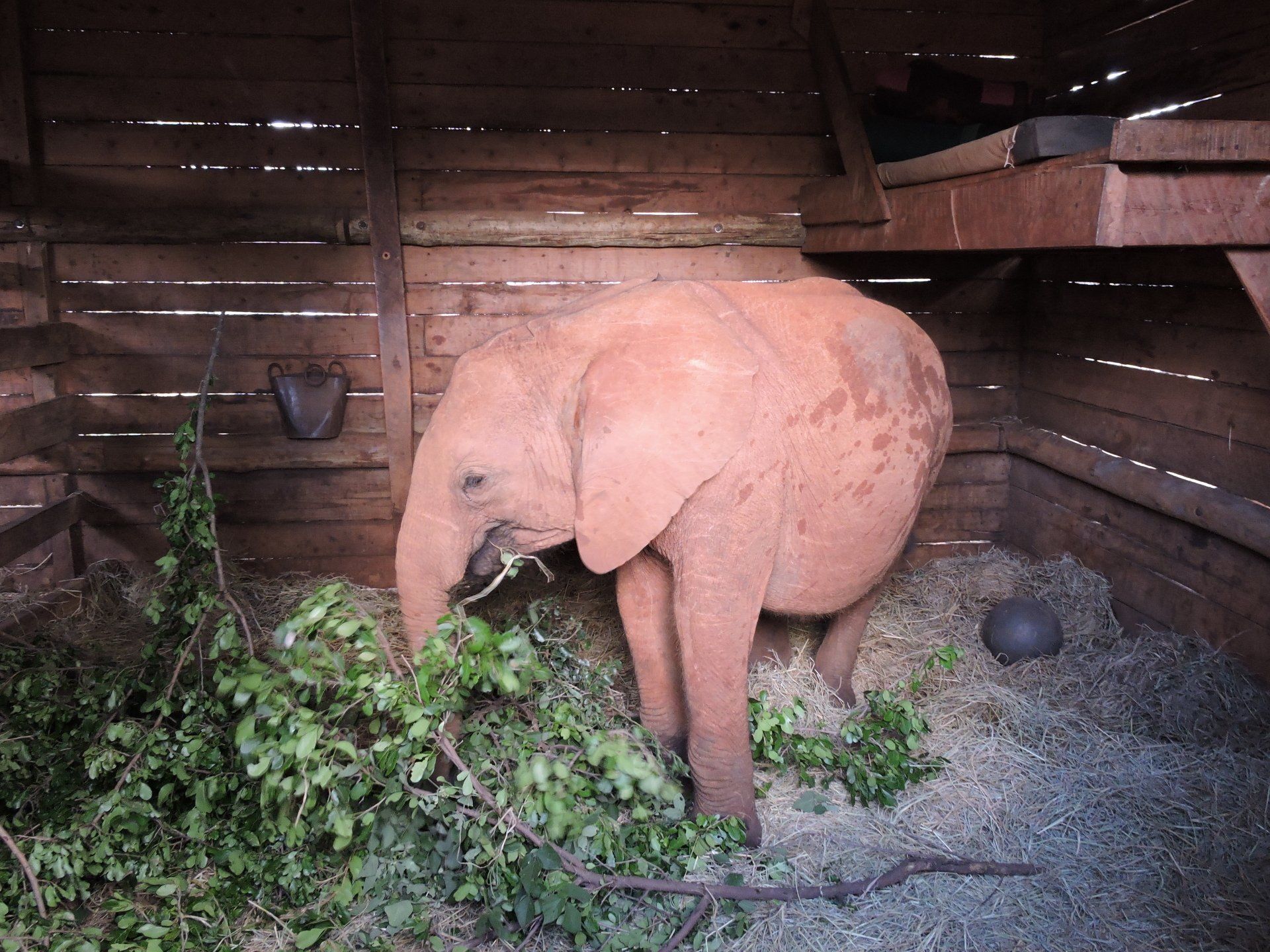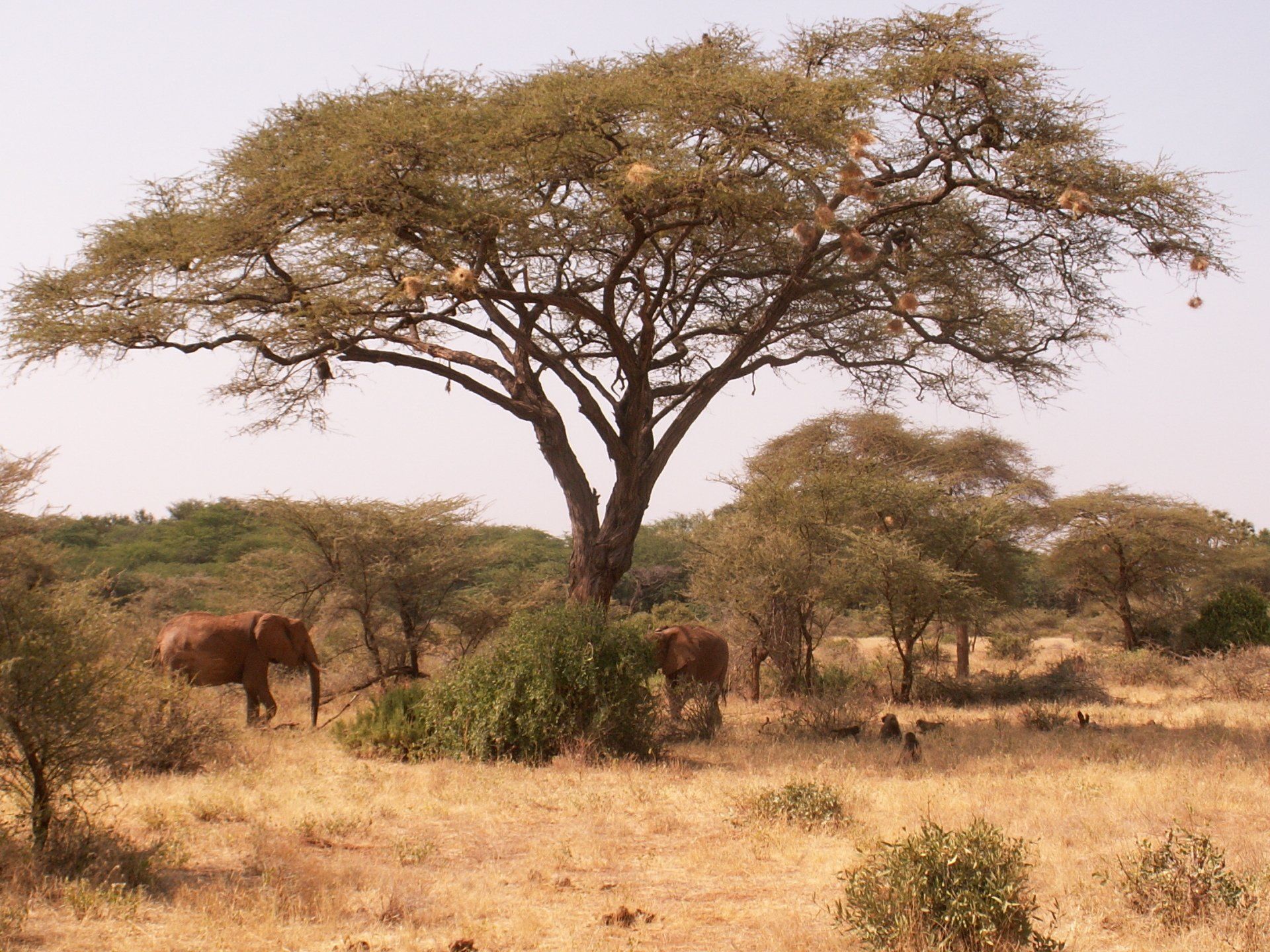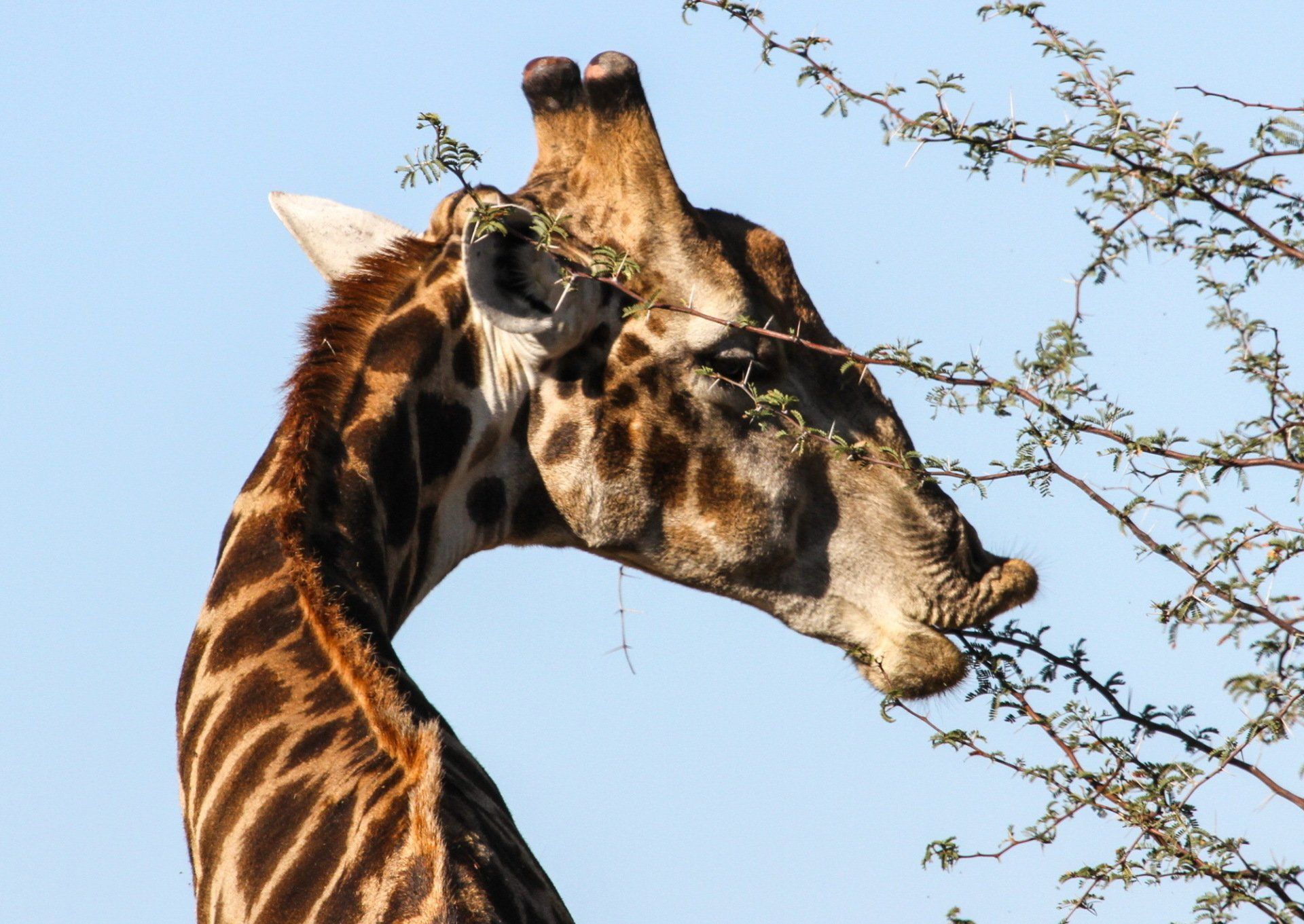ON SAFARI IN KENYA
An ancient land born of ice and fire,
where the savannah is endless and the wildlife is plentiful
Kenya - mystic and wild
Kenya’s vast mosaic of lion-gold savannah, rolling grasslands, ancient rainforests and volcanic plains is a photographer’s paradise.
The country’s extreme climate ranges from tropical heat to glacial ice, forming a diversity of habitats found nowhere else on Earth.
The real draw of visiting Kenya is going on Safari (“journey” in Swahili) in the numerous national parks, conservancies and game reserves, which are home to the Big Five — elephant, lion, leopard, buffalo and rhino.
And with more than 50 ethnic groups, Kenya’s peoples are warm and hospitable, which is best expressed with the national motto ‘Harambee’ meaning ‘let’s all pull together’.
- About Kenya
Kenya rises from the idyllic shores of the Indian Ocean to the snow-capped peaks of Mount Kenya which is an extinct volcano some 3½ million years old.
The landscape of Kenya is distinctly divided into two – the eastern half which slopes gently to the coral-backed seashore, and the western portion, which rises abruptly through a series of hills and plateaus to the Eastern Rift Valley, then slopes to Lake Victoria.
Snow-capped peak of Mount Kenya (5,199 m) is the highest point in the country and the second highest mountain in Africa.
The main rivers are the Athi/Galana and the Tana. Major lakes include Lakes Victoria, Turkana, Baringo, Naivasha, Magadi, Jipe, Bogoria, Nakuru and Elementeita.
The coastline extends some 536 kms between Tanzanian in the south and Somali in the north.
National Parks and Reserves
Kenya’s total wildlife conservation area is 44,359 km² or 7.6 % of the total area.
One of the most popular wildlife destinations, the Maasai Mara, is designated a National Reserve and is the site of the annual Wildebeest Migration.
Flora
Kenya’s flora is diverse. Coastal forests contain palm, mangrove, teak, copal and sandalwood trees.
Forests of baobab, euphorbia and acacia trees cover the lowlands to an elevation of approximately 900 m.
Extensive areas of savannah are interspersed with groves of acacia and papyrus, which characterize the terrain from 900 to 2,750 m above sea level.
Bamboo and camphor are common in the dense rainforest of the eastern and southeastern mountain slopes.
The alpine zone (above 3,550 m) contains many Senecio and Lobelia plants.
Fauna
There are 80 major animal species ranging from the ‘Big Five’ (elephant, buffalo, rhinoceros, lion and leopard) to tiny antelopes such as the dik-dik, which is slightly larger than a rabbit. At least 32 endemic species are endangered.
Avifauna
Kenya boasts around 1,137 species of birds. Spotting over 100 bird species in a day is not uncommon.
UNESCO World Heritage Sites
Fort Jesus, the Gedi Ruins, Koobi Fora, Mount Kenya, Hell’s Gate National Park and the Maasai Mara National Reserve.
National Museums & Historical Sites
Kenya has over 400 historical sites ranging from paleolithic remains, 14th century slave trading settlements, Islamic ruins and the 16th century Portuguese Fort Jesus.
- Wildlife Regions & National Parks
Maasai Mara
Justifiably one of the most famous reserves in Africa, the Mara covers 1,510 km² of great rolling plains of savannah grasslands, dotted with the distinctive flat-topped acacia trees, which sustain the greatest variety of wildlife in Africa and indeed in the world. The concentration of game is at its highest from July through October when the Mara is host to the annual migration of more than a million wildebeest.
The Mara is the Kenyan section of the Serengeti Plains and game viewing is excellent year-round with giraffe, buffalo, zebra, eland, hartebeest and Thompson’s gazelle offering a rich choice for predators, like the lion, leopard and cheetah. During the rainy season, the grass is fairly tall in some areas, which may affect visibility and restrict game drives slightly.
The Maasai people, after whom the park is named, are nomadic. While on game drives, you will often notice young tribesmen herding their cattle amongst the plains game. They are colourfully attired, usually wrapped in bright red cloths, and armed with spears.
Laikipia Wildlife Conservation Area
Lying on the threshold of Kenya’s wild Northern rangelands, Laikipia stretches from the slopes of Mt Kenya to the rim of the Great Rift Valley and is the second largest Kenyan national park. Its magnificent escarpment descends into the arid lands and semi deserts of Northern Kenya.
A sanctuary for over 80 mammal species including black rhino, elephant, lion, leopard, Grevy zebra, reticulated giraffe, aardwolf, wild dog and a wealth of African game, Laikipia’s biodiversity is globally unique.
The ‘Laikipia experience’ comes largely free of the constraints that apply in most national parks and reserves. Night game drives, guided nature walks, bike tours, horse-riding and camel treks – prohibited in most parks – are just some of the exhilarating activities that await visitors to Laikipia.
People too are an integral part of the Laikipia experience. A well-developed tourism infrastructure complete with high levels of community involvement and participation gives the visitor privileged access to the cultures and customs of the region’s Mukogodo Maasai, Samburu, Pokot and other peoples.
Laikipia is a classic example of how well-designed tourism investments can lead to major conservation and economic gains. Hundreds of thousands of acres of land have been set aside over the years by local communities for conservation and ecotourism developments.
Lewa Wildlife Conservancy
Lewa represents a microcosm of one of the world’s most important biological regions in Eastern Africa savannah grasslands. Spanning 61,000 acres, Lewa is home to over 11 percent of Kenya’s black rhino population, over 14 percent of Kenya’s white rhino population and the world’s largest single population of Grevy’s zebra.
Lewa has embodied its mission as a catalyst for conservation. With a proven track record, their model of community-based conservation development is being spearheaded across northern Kenya and emulated by other East African conservation organizations.
Lewa is also home to the Northern Rangelands Trust (NRT), an innovative partnership with communities who have set land aside for wildlife conservation. It provides support to local regions through projects geared towards improving livelihoods and alleviating poverty. Lewa was instrumental in creating the NRT, which has allowed wildlife to begin to migrate once again throughout their historical natural range.
Samburu Game Reserves
Lying in the lower curve of the dry northern Kenya region, the three reserves of Samburu, Buffalo Springs and Shaba make up a combined area of over 235 km² and are well worth a visit to view an ecosystem that spans arid terrains, hills, shrub- and grassland. The main water source, the Uaso Nyiro River, feeds the riverine forest and swamp. The patches of forest and Doum palm dotting the landscape provide an ideal setting for exuberant primates, sombre hippos and sedate crocodiles. Elephant families visit the river’s shallows for a shower or to immerse themselves totally in the invigorating, cool water.
The exciting animal life also includes game only seen north of the equator, namely Grevy’s zebra, Beisa oryx and reticulated giraffe, gerenuk gazelle and the Somali ostrich – known as the ‘big five of the north’.
As the name implies, this is home to the Samburu, a colourful tribal people who have lived in harmonious accord with nature over the years, maintaining cultural conservation practices based on a deep respect for the ecosystem.
Mount Kenya National Park
This 700 km² park is named after Kenya’s highest mountain, said to be home of the Kikuyu God, “Ngai”. Mount Kenya rises to a height of 5,199 m and above the 3,200 m contour it forms a biosphere reserve. The mountain consists of three principal zones: the rocky peak with its crown of glaciers, tarns and snowfields; the alpine zone with distinctive giant vegetation; and the vast gentle slopes covered in upland forest and bamboo jungle, fed by natural mineral springs. The Tana River, largest and longest in Kenya, begins its journey here meandering eastwards for hundreds of kilometers before spilling into the Indian Ocean.
The forest belt is teeming with plants and animals including 11 unique species. Suni antelope, Mount Kenya mole rat, montane viper, black fronted duikers, giant forest hog, and genet cat, are some of the animals on the list.
For the seasoned and physically fit climber, the trek to the peaks is a little difficult and one is advised to spend some days getting acclimatized before making that journey. The climb itself is well worth the effort, seeing the different birds and animals, vegetation, and the changing landscape.
Aberdare National Park
The Aberdares are an isolated volcanic range that forms the eastern wall of the rift valley, running roughly 100 km north south between Nairobi and Thomsons Falls. Soils are red and of volcanic origin, but rich in organic matter. There are two main peaks, Ol Donyo Lesatima (3,999 m) and Kinangop (3,906 m) separated by a long saddle of alpine moorland at over 3,000 m.
The topography is diverse with deep ravines that cut through the forested eastern and western slopes and there are many clear streams and waterfalls. The Aberdares are an important water catchment area providing water to the Tana and Athi rivers and part of Central Rift and Northern drainage basins.
The National Park lies mainly above the tree line running along the 10,000ft contour with some forest and scrub at lower altitude in the ‘salient’ area near Nyeri with the boundary running down to the 7000ft contour the unusual vegetation, rugged terrain, streams and waterfalls combine to create an area of great scenic beauty in the National Park. The park is surrounded by a predominantly indigenous forest. Mist and rain occur throughout much of the year, with precipitation varying from around 1000 mm yearly on the north western slopes to as much as 3000 mm in the south east. Heavy rainfall occurs through most of the year.
Attractions include Lesatima peak, Kinangop peak, waterfalls, walks in the moorlands, Twin hills, Elephant hills and Table mountains, elephants, second largest population of black rhinos in Salient and Northern Aberdares. the Kimathi Hideout, night viewing of wildlife at the Ark and at Treetops.
Fun fact: Queen Elizabeth learned of her accession to the throne at Treetops.
Amboseli National Park
Towered over by the magnificent bulk of Mount Kilimanjaro (5,896 m), Africa’s highest mountain, Amboseli is one of Kenya’s oldest and most-visited parks and is famous for its populations of large mammals. Endlessly panoramic, yet comparatively compact, it is dotted with emerald-green swamps in which great herds of elephant wallow half submerged in the papyrus grasses. The permanent marshlands also provide a potent draw to hippos and buffalo herds, while offering a haven for the abundant water birds.
An International Biosphere Reserve, the park largely constitutes the usually dried-out lakebed of Lake Amboseli, which is surrounded by flat grasslands relieved by very few trees. Wildlife includes lion, cheetah, leopard, elephant, zebra, hippo, spotted and striped hyena, giraffe, numerous antelopes such as oryx, wildebeest, gerenuk, impala and Grant’s gazelle and 425 recorded bird species.
Since being established in 1961, Lake Nakuru National Park has increased considerably in size and now covers an area of 200 km². It surrounds a shallow soda lake, famous for millions of flamingos migrating to its shores, along with tens of thousands of other birds. It is a magnificent sight.
The lake level fluctuates by up to four meters annually. When the water is low the soda crystallizes along the shoreline as a blinding white band of powder. It is surrounded by grassland, bush, forest and rocky cliffs – home to the white rhino, the rare Rothschild’s giraffe, waterbuck, warthogs, large herds of buffalo, Thomson’s gazelle, leopard, hyrax, hippos and many more.
Ol Pejeta Conservancy
The Ol Pejeta Conservancy is 90,000 acres of wilderness and offers an incredibly uncrowded environment to enjoy quality game viewing. The Conservancy is home to Kenya’s largest population of Black Rhino, large numbers of elephant, cheetah, lion, leopard, plentiful plains game and the only place in Kenya to see chimpanzees. There are also a number of rarer Northern species such as Grevys Zebra, Jacksons Hartebeest and Beisa Oryx. The Conservancy lies on the Equator and affords wonderful views of Mt Kenya.
- Country Facts | Climate | Safari FAQ's
The Republic of Kenya
• Area: 583,000 km²
• Capital: Nairobi
• Currency: Kenya Shilling (slang: ‘bob’)
• Population: 41.9 million
• Official language: English (official), Swahili (national), multiple ethnic languages
• Time: GMT +3
Climate:
The coast is hot with an average daytime temperature of 27-31°C, whilst the average daytime temperature in Nairobi is 21-26°C.
July and August mark the Kenyan winter. Nairobi can become cold enough for coats and fleeces; temperatures elsewhere depend on altitude.
Best time to travel:
The main tourist seasons are the drier months of January, February and June to October, when the weather is generally considered to be the best. During the latter period the annual wildebeest migration takes place with thousands of animals streaming into the Maasai Mara from the Serengeti.
Safari FAQ’s
Iconic East Africa
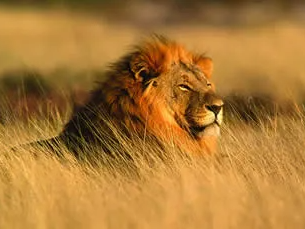
Imagine sitting around the fire at night, gazing at the stars above and listening to the call of the wild...
If you have always dreamed of going to Africa, this safari is ideal for you. Featuring traditional and Meru-style tented lodges, this fly/drive safari offers a wonderful overview of East Africa’s iconic wilderness areas and the opportunity to view wildlife against exceptionally varied backdrops.
Enjoy 9 days on safari in the famous game reserves in Kenya and Tanzania, then fly to the exotic spice isle of Zanzibar for 4 days' relaxation on a tropical beach.
-
Safari Highlights
• Acclimatize in Nairobi
• 3 days of exciting game drives in the famous Maasai Mara
• Fly into the mighty Serengeti and savour 3 days on safari
• Explore the world-famous Ngorngoro Crater
• Enjoy diverse habitats at Tarangire National Park
• Rejuvenation, history and Indian Ocean pleasures on the magical island of Zanzibar
Your safari includes:
• 1 night in Nairobi, 8 nights in both luxury Meru-style tented safari camps and traditional Safari lodges, and 4 nights in paradise at a beach resort
• Breakfast in Nairobi, all meals on safari, dinner and breakfast in Zanzibar
• Game drives, transfers and touring in air-conditioned 4×4 game drive vehicles
• Services of English speaking highly qualified, professional local guides
Contact Kenya Travel Specialist, Christine Boecker to book your East African Safari
(AH)
-
Itinerary Overview
Day 1 Nairobi, Kenya
Upon arrival you will be met and transferred to a luxury hotel near Nairobi’s international airport.
While in Nairobi:
Depending on your time of arrival we will arrange a visit to the David Sheldrick Elephant Orphanage – where a dedicated team nurture orphaned elephant babies and reintegrate them into the African wilderness.
Rothschild Giraffe Centre is an environmental conservation center, tasked with rescuing the endangered Rothschild giraffes and educating Nairobi’s school children and youth about the importance of wildlife preservation.
Day 2 Maasai Mara
Travel up the floor of the Rift Valley to the Maasai Mara National Reserve, one of the most famous game reserves in Africa and the traditional land of the nomadic Maasai people.
Your tented camp – home for the next 3 nights – is located in the heart of the Maasai Mara Game Reserve is laid out over sprawling grounds.
Days 3 & 4 On Safari in the Mara
Savour two days in the reserve with morning and afternoon game drives in the Mara, a pristine wilderness of haunting beauty promising a profusion of wildlife, prolific bird life and the unprecedented opportunity in search of the Big Five.
Day 5 Fly to Serengeti, Tanzania
Depart from the local airstrip on a light aircraft transfer to the Serengeti. Here you will be met by your Tanzanian guide for an afternoon game drive by 4×4 safari vehicle, en-route to your safari lodge, set high on a tree-clad ridge with commanding views over the endless miles of lion-gold savannah that is the Serengeti.
Days 6 & 7 On Safari in the Serengeti
Enjoy two days on safari with morning and afternoon game drives. The Serengeti, whose Maasai name ‘Siringet’ translates as ‘the endless plains’, is an unrivalled natural arena for a plethora of wildlife species, including the Big 5 and offers unparalleled ornithological opportunities.
Day 8 Ngorongoro Crater via Olduvai Gorge
Travel to the enthralling Ngorongoro Crater Conservation Area. En-route visit Olduvai Gorge – the ‘Cradle of Mankind’ and site of hominid fossils, one of the most important palaeolithic finds in recent history.
Later descend to the crater floor for a game drive, before arriving at your lodge, situated on the edge of the crater wall.
Day 9 Ngorongoro Crater & Tarangire National Park
Enjoy a morning safari in the iconic Ngorongoro Crater, stretching across some 8,300 km² and home to a blend of landscapes, wildlife, people and archaeology that is unsurpassed in Africa.
Travel to Tarangire National Park for a game drive is this arid haven, peppered with ancient baobab trees and towering termite mounds. It is the home of the greatest concentration of elephants in East Africa, and other game including the elusive leopard and over 400 bird species.
Days 10 – 13 Zanzibar
Drive to Arusha Airport for your flight to Zanzibar, for a rejuvenating four day stay at a beachfront resort. With white sandy beaches and crystal blue waters, your resort offers a wide selection water sports and cultural entertainment, as well as a tour of historical Stone Town.
Day 14 Depart Africa
Enjoy your last morning on this exotic island, before being transferred to the airport for your homeward flight after a memorable African safari!
Contact Kenya Travel Specialist, Christine Boecker to book your East African Safari
(AH)
Great Pioneer Safari
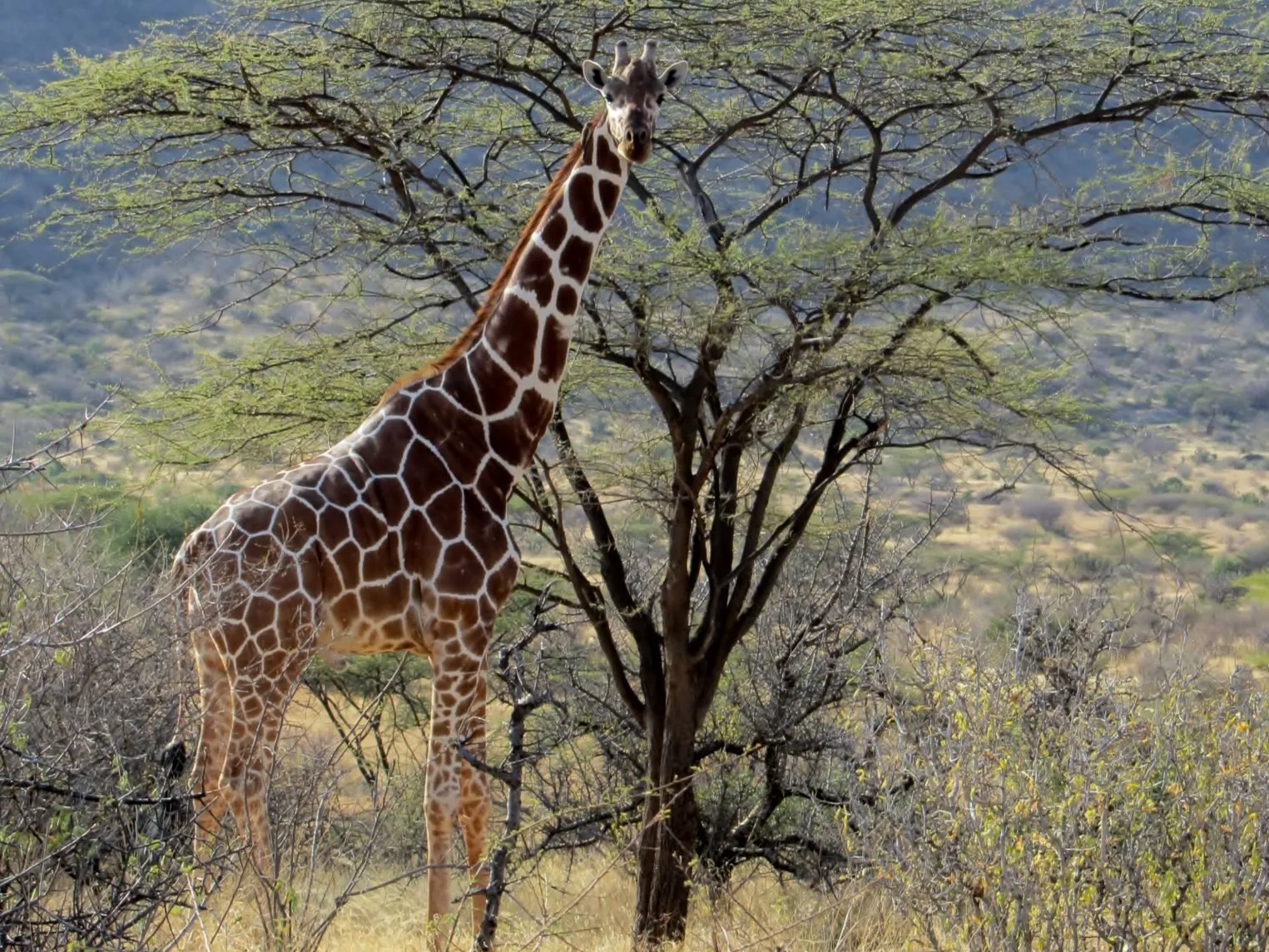
This Kenyan fly-in Safari is unlike any other, with abundant wildlife, spectacular scenery and extraordinary cultural diversity, while staying in tented eco camps.
On our safari you will explore four diverse ecosystems and savour uncrowded wildlife sightings in private conservancies, rarely experienced in Kenya.
Protecting Africa’s pristine wilderness is what drives us. Your patronage makes a difference by contributing directly to local communities and to the conservation of endangered African wildlife.
For a wilderness experience, you simply can’t beat it.
-
Safari Highlights
• Small, authentic tented eco-safari camps
• Exclusive access to wildlife areas in private conservancies
• Personal attention of qualified safari guides
• Game drives in open-sided 4×4 safari vehicles
• Escorted game walks and night game drives
Contact Kenya Travel Specialist, Christine Boecker to customize this safari for you
(GW)
-
Itinerary Overview
Day 1 Nairobi, Kenya
Upon arrival at Nairobi Airport, you will be met and transferred to your hotel in Nairobi, set on 12 acres of landscaped gardens and embracing the traditionally hospitable nature of Kenya to make you feel right at home. Simple luxury and comfort can be enjoyed in the privacy of spacious rooms that overlook the lush gardens. Facilities include a pool with deck and terrace where guests can unwind and enjoy beverages and light meals.
While in Nairobi:
Enjoy an excursion to the Daphne Sheldrick Elephant Orphanage – where a team of trained elephant keepers rehabilitate orphaned elephants and transition them back to the wilderness.
Visit the Rothschild Giraffe Centre – rescuing the endangered Rothschild giraffes and providing conservation education for school children and youth of Kenya.
Day 2 Amboseli
Morning flight to Amboseli and transfer to your safari camp, home for the next 2 nights. With just 9 spacious guest Meru-style tents, this eco-camp retains all the charm of the traditional luxury camps of days gone by.
Enjoy an evening walk with the Masai, sundowners & night game drive in the conservancy.
Day 3 On safari in Amboseli
Enjoy a full day’s game viewing around the world-famous Amboseli National Park. Towered over by the magnificent bulk of Mount Kilimanjaro, Africa’s highest mountain at 5,896 m, Amboseli is one of Kenya’s oldest and most-visited parks, dotted with emerald-green swamps in which great herds of elephant wallow. The permanent marshlands also provide a potent draw to hippos and buffalo herds, while offering a haven for the abundant water birds.
Day 4 Ol Pejeta Game Conservancy
Morning flight to Ol Pejeta, your base for the next 2 nights. Your camp, on the banks of a seasonal river and under the shade of acacia trees, consists of just 6 spacious and comfortable guest tents, each having been carefully sited to take advantage of the wonderful surrounding views and designed to have minimum environmental impact.
Day 5 On safari in Ol Pejeta
Enjoy a day of game activities in open-sided 4×4 safari vehicles with expert safari guides in 90,000 acres of wilderness that is the Ol Pejeta Game Conservancy, home to Kenya’s largest population of Black Rhino, large numbers of elephant, cheetah, lion, leopard, plentiful plains game and the only place in Kenya to see chimpanzees. There are also a number of rarer Northern species such as Grevys Zebra, Jacksons Hartebeest and Beisa Oryx. The Conservancy lies on the Equator and affords wonderful views of Mt Kenya.
Day 6 Maasai Mara
Morning flight to the Maasai Mara Game Reserve and the Ol Kinyei Conservancy, your home for the next 2 nights. Placed in a unique and beautiful setting under yellow-barked Acacia trees along the banks of the Laetoli River, the eco-camp consists of just 6 spacious guest tents and has an exclusive, yet friendly feel. The camp chef uses fresh ingredients to prepare high quality meals and even home-baked bread. This is the ideal area for a Hot Air Balloon Safari.
Day 7 On safari in the Ol Kinyei Conservancy
Enjoy a full day of game activities and experience the wilderness without the presence of other tourist vehicles. This exclusive 17,500 acre wilderness area has open plains, forests, rivers and stunning views. It borders the 50,000 acre Naboisho Conservancy, which is also accessible for game viewing.
Day 8 Olare Orok Conservancy
Game drive through Naboisho Conservancy to your next camp, located in a unique setting on the banks of the seasonal Ntiakatiak River within the Olare Orok Conservancy. The eco-camp – with just 10 tents – ensures guests have a genuine “away from it all” experience deep in the African bush.
Days 9 & 10 On safari in the Mara and Olare Orok Conservancy
Enjoy the next 2 days on safari on this large conservancy and in the Masai Mara National Reserve. The unsurpassed game-viewing within the conservancy, which is home to an abundance of wildlife, including the Mara’s renowned Big Cats.
Day 11 Depart Africa
Spend your last morning enjoying the uninterrupted views of the spectacular African bushveld before being transferred to the airstrip for your flight to Nairobi.
Contact Kenya Travel Specialist, Christine Boecker to customize this safari for you
(GW)
Kenya for Connoisseurs
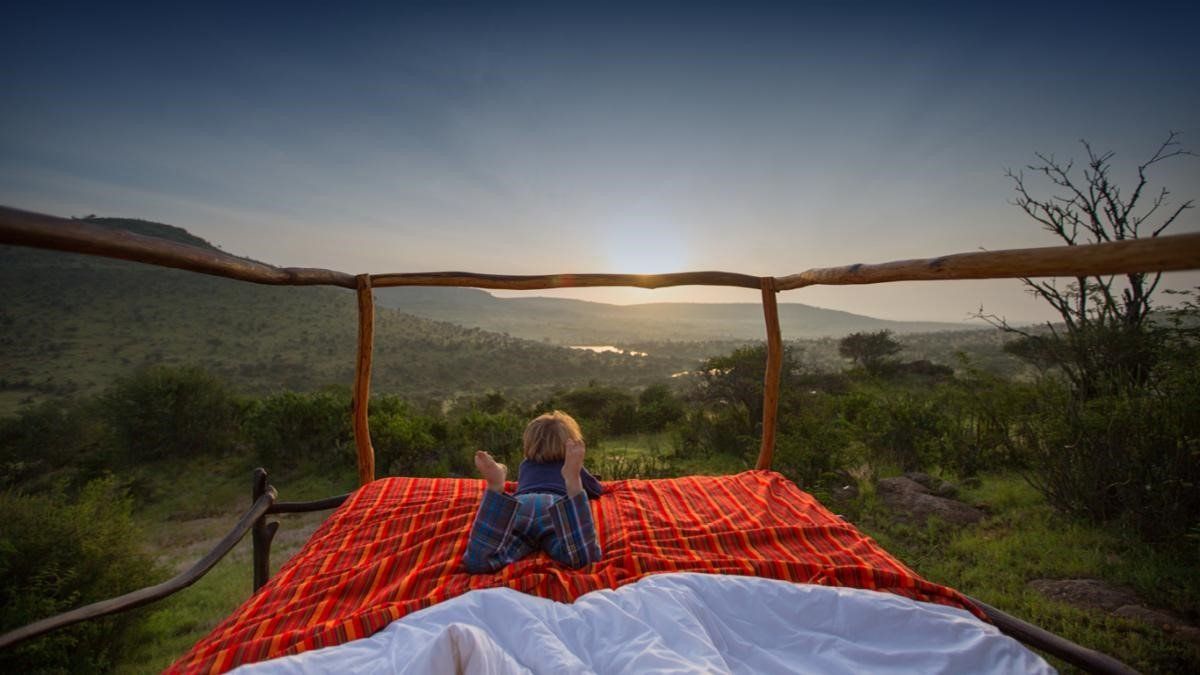
Our off-the-beaten-track safari has it all. It is as much about enjoying the wildlife and vast wilderness as it is about discovering the local culture – both intricate parts of what Kenya has to offer.
Take the family and Travel with Purpose on this unhurried safari in 2 vast private conservancies in northern Kenya, where you will find the Big Five and the Northern Five!
Go beyond the game drive, with exceptional wildlife and wilderness viewing opportunities and even enjoying a sleep-out under the vast African sky.
-
Safari Highlights
- Family-owned luxury safari lodges in private conservancies
- Exclusive access to wildlife viewings
- Highly trained, experienced wilderness guides
- Day & night game viewing in 4x4 safari vehicles
- Immersive, guided bush walks in the wild
- Camel and horseback safaris
- Bush brunch by the river or a picnic lunch at a magnificent waterfall
- Sleep out under the stars in the wild
- Pick fresh fruit & veg, collect eggs from the organic gardens, then cook with the chef
- Visit GAAMY, the original 1929 Gypsy Moth bi-plane from OUT OF AFRICA
- Take a scenic flight in a WACO bi-plane ($)
- Enjoy a helicopter ride to see Mount Kenya and the Great Rift Valley from above ($)
- Join in conservation activities, such as wildlife monitoring to see vital elephant corridors
- Visit local communities
- Take the day to pamper yourself with botanical spa treatments at the holistic wellness center
This family friendly safari will light up the imagination of the younger generation.
Contact Kenya Travel Specialist, Christine Boecker to customize this safari for you
(LW&S)
-
Itinerary Overview
Day 1 Lewa Wilderness
Fly from Nairobi directly to Lewa, where you are warmly greeted and transferred to the lodge, enjoying a game drive enroute. Traditional sundowners are followed by a candle-lit dinner.
Days 2 – 4 On Safari in the Lewa Conservancy
Lewa Wilderness is situated on 62 000 acres of pristine wilderness, one of Kenya’s major private conservancy success stories. The wildlife-rich Lewa has been family owned since 1972 and is renowned for its high density of wildlife including the Big 5 and all of Kenya’s Northern 5 - reticulated giraffe, Grevy's zebra, Beisa oryx, gerenuk and the Somali ostrich. The rhino population on Lewa is sensational with incredible rhino sighting opportunities.
This welcoming and intimate lodge is especially favoured amongst families and couples looking for a varied safari experience. Enjoy a myriad of activities from traditional game drives and guided bush walks to horse riding safaris for all ages and levels and camel safaris – even breathtaking scenic flights in the retro yellow WACO bi-plane – all very Out of Africa!
Once you’ve had your fill of wildlife viewing you can visit the local community to gain insight into local life.
Each of the ten spacious cottages, perched along the hillside overlooking an expansive valley, are luxuriously furnished with handmade furniture to give them the comfortable and rustic character of a ranch homestead. A private fireplace and veranda are fine places to relax. Natural springs, home-raise livestock, and a 5-acre organic garden are the source of the healthy and delicious cuisine. The swimming pool and tennis court invite young and old to relax and play.
Your stay supports a number of wildlife conservation initiatives as well as community and education programs.
Day 5 – Laikipia
Departure after breakfast, flying directly to Laikipia, where you will be welcomed and transferred to your lodge, situated on the grasslands of the Laikipia Plateau, overlooking Mount Kenya. After settling in to one of the 9 private villas, enjoy a drink at the bar, then move to the open-air dining room, filled with contemporary African art, for a delicious and healthy dinner, created using home-grown, organic and free-range ingredients.
Days 6 – 8 On Safari in Laipikia
Savour 3 days in this malaria-free oasis of luxury in 50 000 acres of wild Kenyan savannah, situated between Mount Kenya and the Great Rift Valley – one of the most densely populated regions for wildlife in Kenya with thrilling safari opportunities.
Expect to see big cats like lions and cheetahs, roaming herds of elephant and buffalo, as well as endangered species, including reticulated giraffe, Grevy’s zebra, Lelwel’s Hartebeest, Patas monkeys and African wild dog. Seek out these species as well as varied plains game and incredible birdlife on daily game drives in open-sided 4x4 safari vehicles, on guided bush walks, on camels or on horseback.
Beyond wildlife viewing you can gather wild honey in bee-suits, walk with anti-poaching tracker dogs, meet with East Africa's first female conservation ranger team, go shopping at the local market, take a guided African art tour, visit a Samburu manyatta (homestead) to experience rural life or sleep out under the stars for an unforgettable night filled with the sounds of Africa!
This contemporary luxury lodge lies in the high grasslands of the Laikipia Plateau, its nine private timber and thatch villas raised above a profusion of botanical life to offer views towards Mount Kenya. Each large, en-suite bedroom has a private deck with sun loungers, swing bed and sunken Jacuzzi. Built on stilts, with thatched roofs and expansive decks that overlook the savannah, the luxurious villas feature king beds and generous day beds that can be turned into romantic overnight sleep-outs. The Family Villa has two adjoining suites with a shared living area and large deck.
With many extraordinary indoor and outdoor settings, dining is a real treat with the chef delivering delicious farm-to-fork meals, using organic and free-range ingredients.
Local community work and sustainable technologies are part of the lifeblood of this lodge, which is entirely solar powered. Rainwater is harvested and waste is composted or recycled. Your stay contributes to the livelihoods and traditional cultures of local communities.
Day 9 – End of Safari
Enjoy a last early morning game drive, heading to the airstrip after breakfast for your flight to Nairobi and arriving in time to connect with your international flight home.
While in Nairobi:
If time permits, we will arrange a visit to the Daphne Sheldrick Elephant Orphanage which rehabilitates orphaned elephants and transitions them back to the wilderness.
Here you can delight in observing the bedtime routine of these little elephants, as their team of trained keepers tuck them in for the night – an experience you will not soon forget!
(LW&S)
BeWILDered about Africa? We specialize!
Visit About African Safaris to learn what you can experience on your safari. We debunk common safari myths, elaborate on safari styles, describe the Big Five and address frequently asked questions. More >>
TESTIMONIALS

“Thank you, Christine, for putting together our trip of a lifetime to Kenya and Tanzania — it is one we will never forget and was more than we hoped for!”
Garry, Port Coquitlam BC

“Spectacular! It’s the only word to describe my entire trip. As the camps you chose for us are in conservancies adjacent to the national parks, we could experience peaceful and virtually private access to an amazing variety of wildlife. Thank you, Christine!”
Michele, Vancouver BC

“Christine arranged another trip for me - this time to Kenya for me and my friends. Christine planned a superb safari for us and everything worked perfectly. I will be happy to use Christine’s services in the future and continue to recommend her to my friends.”
Diane, Gabriola BC
Memories from Christine's Kenya Safaris:
TRΛVELBOECKER ΛDVENTURES Insider’s Reports:

GET IN TOUCH
TRΛVELBOECKER TΛILOR-MΛDE
Unique Safaris designed to meet your Personal Vision
OVERVIEW
CONTACT
LOCATION
Vancouver BC
Canada
Div. of PTM Ltd. | BC Reg #2806
© TRΛVELBOECKER ΛDVENTURES 2002 - 2022





